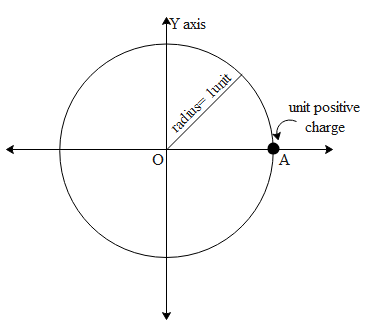
An electric line of force in the XY plane is given by the equation
a) not move at all
b) will move along the straight line
c) will move along the circular line of force
d) information is insufficient to draw any conclusion
Answer
508.2k+ views
Hint: An electric line of force is basically the line of action of force that exists due do the electric field of a charge distribution or a unit charge. If we look at the equation of the line of force i.e.
Complete step by step answer:

As shown in the fig a unit positive charge is kept at x= 1unit. If we consider the equation of the line of action of force the, for x = 1, and y = 0 the equation is satisfied. Hence the charge is in the influence of the electric field region. If we look at the above diagram, the lines of force exist in a circular region which is only possible if there is a charge at the origin. If there exists a charge Q at the origin by Coulomb's law the force on the charge at a distance r is given by
Hence, the correct answer is option B.
Note:
It is not specified in the question about the nature of the charge placed at origin nor the direction of the line of force. If the charge is positive then the unit positive charge will move away from the origin. If the charge placed at the origin is negative then the unit positive charge will move towards the origin. This is based on the fact that like charges repel each other and unlike charges attract each other.
Complete step by step answer:

As shown in the fig a unit positive charge is kept at x= 1unit. If we consider the equation of the line of action of force the, for x = 1, and y = 0 the equation is satisfied. Hence the charge is in the influence of the electric field region. If we look at the above diagram, the lines of force exist in a circular region which is only possible if there is a charge at the origin. If there exists a charge Q at the origin by Coulomb's law the force on the charge at a distance r is given by
Hence, the correct answer is option B.
Note:
It is not specified in the question about the nature of the charge placed at origin nor the direction of the line of force. If the charge is positive then the unit positive charge will move away from the origin. If the charge placed at the origin is negative then the unit positive charge will move towards the origin. This is based on the fact that like charges repel each other and unlike charges attract each other.
Recently Updated Pages
Master Class 12 Business Studies: Engaging Questions & Answers for Success

Master Class 12 English: Engaging Questions & Answers for Success

Master Class 12 Social Science: Engaging Questions & Answers for Success

Master Class 12 Chemistry: Engaging Questions & Answers for Success

Class 12 Question and Answer - Your Ultimate Solutions Guide

Master Class 11 Economics: Engaging Questions & Answers for Success

Trending doubts
Draw a labelled sketch of the human eye class 12 physics CBSE

a Tabulate the differences in the characteristics of class 12 chemistry CBSE

Which one of the following is a true fish A Jellyfish class 12 biology CBSE

Why is the cell called the structural and functional class 12 biology CBSE

Differentiate between homogeneous and heterogeneous class 12 chemistry CBSE

Write the difference between solid liquid and gas class 12 chemistry CBSE




